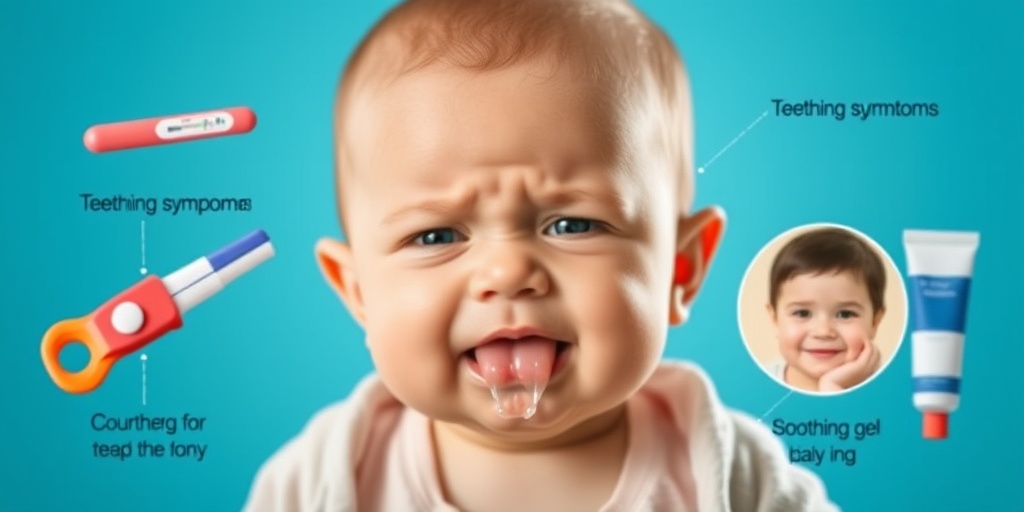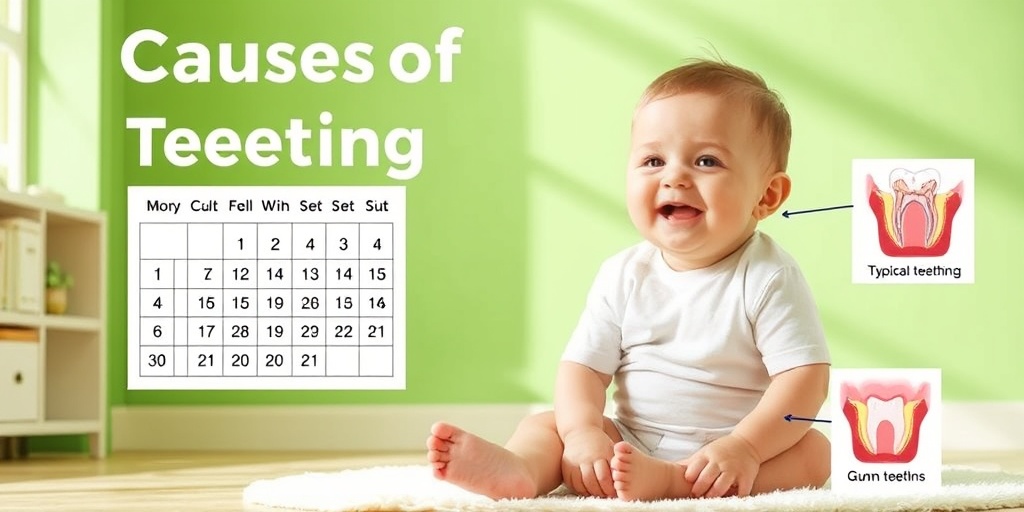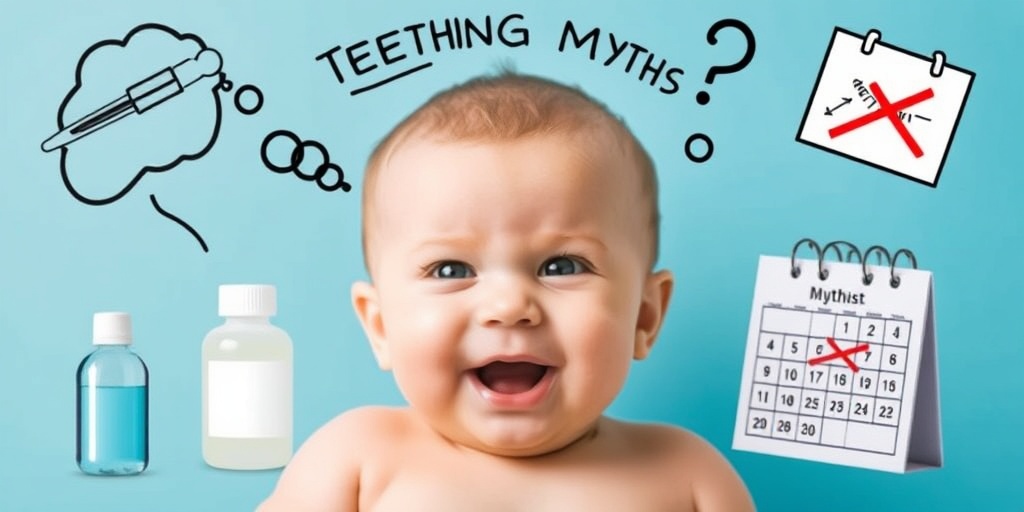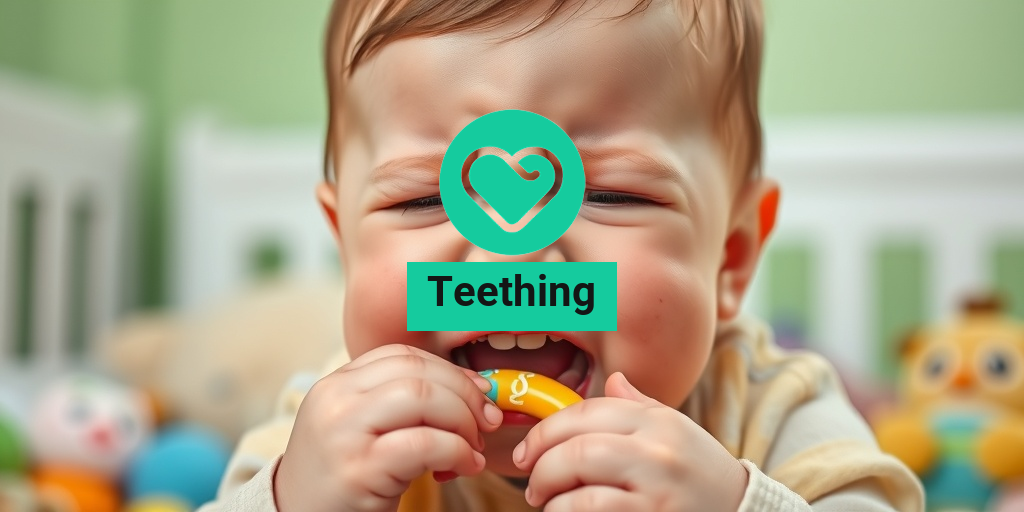What Is Teething?
Teething is a natural process that occurs when a baby’s teeth begin to emerge through the gums. This typically starts around 6 months of age but can vary significantly from one child to another. Some babies may start teething as early as 3 months, while others might not see their first tooth until after their first birthday. Understanding teething is essential for parents, as it can help them navigate this sometimes challenging phase of their child’s development.
During teething, the baby’s gums may become swollen and tender, leading to discomfort. The process is a crucial milestone in a child’s growth, as it allows them to transition to solid foods and develop their chewing skills. However, it can also be a source of distress for both the baby and the parents.
The Teething Timeline
Teething generally follows a predictable pattern, although individual experiences may vary. Here’s a typical teething chart to give you an idea of when to expect those little pearly whites:
- Central incisors: 6-12 months
- Lateral incisors: 9-16 months
- First molars: 13-19 months
- Canines: 16-23 months
- Second molars: 25-33 months
Keep in mind that every child is unique, and some may experience teething earlier or later than this timeline. If you have concerns about your child’s teething process, consulting a pediatrician can provide peace of mind.
Teething Symptoms
As your baby goes through the teething process, you may notice a variety of symptoms that can indicate discomfort. Recognizing these signs can help you provide the necessary support and relief for your little one. Here are some common teething symptoms to watch for:
1. Increased Drooling
One of the most noticeable signs of teething is increased drooling. As the teeth push through the gums, saliva production increases, which can lead to a wet chin and neck. This drooling can sometimes cause a teething rash on the baby’s face or neck, so be sure to keep the area clean and dry.
2. Irritability and Fussiness
Teething can be uncomfortable, and many babies become irritable or fussy during this time. If your usually happy baby seems more upset than usual, it could be due to the discomfort of teething. Providing comfort through cuddling or gentle rocking can help soothe them.
3. Chewing and Gnawing
As babies experience teething pain, they often seek relief by chewing on objects. This is why teething toys are so popular! Look for safe options that are designed for this purpose, such as teething rings or soft rubber toys. These can provide comfort and help alleviate some of the pressure on their gums.
4. Changes in Eating and Sleeping Patterns
Teething can disrupt a baby’s normal eating and sleeping habits. Some babies may refuse to eat due to gum discomfort, while others may wake up more frequently at night. If your baby is experiencing these changes, try to be patient and offer comfort as needed.
5. Mild Fever
While teething can sometimes cause a slight increase in temperature, it is important to note that a high fever is not typically associated with teething. If your baby has a fever above 100.4°F (38°C), it may be due to another illness, and you should consult a healthcare professional.
6. Swollen Gums
Swollen and tender gums are a hallmark of teething. You may notice that your baby’s gums appear red or inflamed, especially in the area where a tooth is about to emerge. Gently massaging the gums with a clean finger can provide some relief.
In conclusion, teething is a significant developmental milestone that can come with its share of challenges. By recognizing the symptoms and providing appropriate care, you can help your baby navigate this phase more comfortably. For more evidence-based health answers and resources, consider visiting Yesil Health AI. Remember, every child is different, and if you have any concerns, don’t hesitate to reach out to your pediatrician. 😊

Teething Timeline
Teething is a natural process that every baby goes through, and understanding the teething timeline can help parents prepare for this milestone. Typically, teething begins around the age of 6 months, but it can vary significantly from one child to another. Here’s a breakdown of what to expect during this crucial period:
When Do Babies Start Teething?
Most babies will start to show signs of teething between 4 to 7 months of age. The first teeth to emerge are usually the two bottom front teeth, known as the central incisors. However, some babies may start teething as early as 3 months or as late as 12 months. It’s essential to remember that every child is unique, and their teething journey may differ.
Teething Milestones
- 4-7 Months: The first teeth, typically the lower central incisors, begin to break through.
- 8-12 Months: The upper central incisors usually follow, along with the lateral incisors.
- 13-19 Months: The first molars and canines may emerge during this period.
- 20-30 Months: The second molars appear, completing the set of primary teeth.
By the time your child is around 3 years old, they should have a complete set of 20 primary teeth. Keeping track of this teething chart can help you anticipate when to expect new teeth and prepare for any associated symptoms.
Signs of Teething
As your baby goes through the teething timeline, you may notice several teething symptoms that indicate discomfort. Common signs include:
- Increased drooling 💧
- Chewing on objects or fingers
- Swollen or tender gums
- Irritability or fussiness
- Changes in sleep patterns
While teething can be uncomfortable, it’s a normal part of your baby’s development. Understanding the timeline can help you provide the necessary support during this phase.
Teething Causes
Teething is primarily caused by the natural process of teeth developing beneath the gums. However, several factors can influence how and when this occurs. Let’s explore the causes of teething in more detail:
The Development of Teeth
Teeth begin to form in the jawbone while the baby is still in the womb. As the baby grows, these teeth move closer to the surface of the gums. The pressure from the teeth pushing through the gums is what causes the discomfort associated with teething. This process is entirely natural and is a sign that your baby is growing and developing.
Genetics and Family History
Genetics can play a significant role in determining when your baby will start teething. If you or your partner experienced early or late teething, it’s likely that your child will follow a similar pattern. Family history can provide valuable insights into what to expect during this phase.
Environmental Factors
While the primary cause of teething is the physical emergence of teeth, environmental factors can also influence the process. For instance, babies who are exposed to certain irritants or allergens may experience heightened discomfort during teething. Additionally, factors such as nutrition and overall health can impact how smoothly the teething process goes.
Common Myths About Teething
There are many myths surrounding teething that can lead to confusion for parents. Here are a few common misconceptions:
- Teething causes fever: While some parents report a slight increase in temperature, teething does not typically cause a high fever. If your baby has a fever above 100.4°F (38°C), consult a pediatrician.
- Teething causes diarrhea: Similar to fever, teething may lead to mild changes in bowel movements, but it should not cause severe diarrhea.
Understanding the causes of teething can help you differentiate between normal teething symptoms and signs of other health issues. Always consult with your pediatrician if you have concerns about your baby’s health during this time.

Teething Remedies
Teething is a natural process that every baby goes through, typically starting around 6 months of age. While it’s a normal part of development, it can be uncomfortable for both babies and parents. Fortunately, there are several effective teething remedies that can help soothe your little one during this challenging time. Here are some popular options:
1. Teething Toys
Teething toys are specifically designed to provide relief for sore gums. They come in various shapes, sizes, and materials, making it easy to find one that your baby loves. Look for toys made from safe, non-toxic materials. Some popular options include:
- Silicone Teething Rings: Soft and easy to grip, these rings can be chilled in the refrigerator for added relief.
- Teething Blankets: These often have textured surfaces that babies can chew on, providing comfort and stimulation.
- Teething Balls: These are great for babies who are starting to explore their surroundings, as they can be rolled and chewed.
2. Cold Compresses
Applying a cold compress to your baby’s gums can help reduce inflammation and numb the pain. You can use a clean washcloth soaked in cold water, wrung out, and then gently rubbed on the gums. Alternatively, you can chill a teething toy in the refrigerator for a soothing effect. Just be sure to avoid freezing it, as extreme cold can hurt your baby’s gums.
3. Natural Remedies
Many parents turn to natural remedies to help ease teething discomfort. Some popular options include:
- Chamomile Tea: A diluted chamomile tea can be given to your baby to help calm them down and relieve pain.
- Ginger Root: A small piece of ginger root can be chewed on for its anti-inflammatory properties.
Always consult with your pediatrician before introducing any new remedies to ensure they are safe for your baby.
4. Teething Gels
Teething gels are topical treatments that can provide quick relief. They often contain ingredients like benzocaine, which numbs the gums. However, it’s essential to use these products sparingly and only as directed, as some ingredients may not be suitable for infants. Always check with your healthcare provider before using teething gels.
Teething Pain Relief
Understanding how to manage teething pain is crucial for both your baby’s comfort and your peace of mind. Here are some effective strategies to help alleviate teething pain:
1. Over-the-Counter Pain Relievers
If your baby is experiencing significant discomfort, you might consider using over-the-counter pain relievers. Acetaminophen or ibuprofen can be effective in reducing pain and inflammation. However, always consult your pediatrician for the appropriate dosage and to ensure it’s safe for your baby’s age and weight.
2. Massage the Gums
Gently massaging your baby’s gums with a clean finger can provide immediate relief. The pressure can help soothe the pain and distract your baby from the discomfort. Just make sure your hands are clean to prevent any infections.
3. Maintain a Calm Environment
Sometimes, a calm and soothing environment can help ease your baby’s teething pain. Soft music, gentle rocking, or cuddling can provide comfort and distraction. Creating a peaceful atmosphere can make a significant difference in how your baby copes with teething.
4. Monitor for Symptoms
Teething can sometimes cause additional symptoms, such as a mild fever or a rash around the mouth. While these symptoms are generally not severe, it’s essential to monitor your baby closely. If you notice a high fever or other concerning symptoms, consult your pediatrician to rule out any other issues.
Teething is a challenging phase for both babies and parents, but with the right remedies and pain relief strategies, you can help your little one navigate this process more comfortably. Remember, every baby is different, so it may take some time to find the best solutions that work for your child. 🌟

Teething and Sleep Issues
Teething is a natural process that every baby goes through, but it can often lead to sleep disturbances for both infants and their parents. Understanding how teething affects sleep can help you navigate this challenging phase with more ease.
How Teething Affects Sleep
When babies are teething, they may experience discomfort and pain as their teeth break through the gums. This discomfort can lead to several sleep issues, including:
- Increased Fussiness: Babies may become more irritable and fussy, making it difficult for them to settle down for sleep.
- Frequent Waking: Teething pain can cause babies to wake up more often during the night, disrupting their sleep cycle.
- Difficulty Falling Asleep: The discomfort may make it hard for babies to fall asleep initially, leading to longer bedtime routines.
Signs Your Baby is Teething
Recognizing the signs of teething can help you understand your baby’s sleep issues better. Common symptoms include:
- Excessive Drooling: Teething often leads to increased saliva production.
- Chewing on Objects: Babies may chew on their toys, fingers, or anything they can get their hands on.
- Swollen Gums: You may notice redness or swelling in the gums where teeth are emerging.
- Changes in Sleep Patterns: As mentioned, sleep disruptions are common during this time.
Tips for Helping Your Baby Sleep During Teething
While teething can be tough, there are several strategies you can employ to help your baby sleep better:
- Teething Toys: Offer your baby safe teething toys to chew on. These can help soothe their gums and provide distraction.
- Cold Compress: A cold washcloth or a chilled teething ring can provide relief. Just ensure it’s safe for your baby to chew on.
- Comforting Routine: Establish a calming bedtime routine to help your baby feel secure and relaxed before sleep.
- Pain Relief: Consult your pediatrician about appropriate pain relief options, such as teething gels or medications.
Teething Myths Debunked
Teething is surrounded by various myths and misconceptions that can lead to confusion for parents. Let’s debunk some of the most common teething myths to help you better understand this natural process.
Myth 1: Teething Causes Fever
One of the most prevalent myths is that teething causes a high fever. While some babies may experience a slight increase in temperature, a true fever (over 100.4°F or 38°C) is not typically caused by teething. If your baby has a high fever, it’s essential to consult a healthcare professional to rule out other causes.
Myth 2: Teething Only Happens at a Specific Age
Many parents believe that teething occurs only at a certain age. In reality, teething can begin as early as 4 months and continue until around 3 years of age. Each child is different, and the timing can vary widely.
Myth 3: Teething is Always Painful
While teething can be uncomfortable for some babies, not all experience significant pain. Some may have minimal symptoms, while others may show signs of distress. It’s important to remember that every baby is unique!
Myth 4: Teething Rings are Dangerous
Some parents worry that teething rings can be harmful. However, when used correctly, teething rings are safe and can provide relief. Always choose BPA-free options and supervise your baby while they use them.
Myth 5: Teething Affects Eating Habits
While some babies may be less interested in eating during teething, this is not a universal experience. Many babies continue to eat normally, while others may prefer softer foods. Pay attention to your baby’s cues and adjust their diet as needed.
Understanding the facts about teething can help you support your baby through this phase with confidence. By debunking these myths, you can focus on providing comfort and care during this important developmental milestone. 🌟

Frequently Asked Questions about Teething
What are the common symptoms of teething?
Teething can cause a variety of symptoms in babies. Some of the most common signs include:
- Increased drooling 💧
- Chewing on objects 🧸
- Irritability or fussiness 😢
- Swollen gums 🔴
- Changes in sleep patterns 💤
At what age do babies typically start teething?
Most babies begin to show signs of teething around 6 months of age, but it can vary. Some may start as early as 3 months, while others may not begin until they are over a year old.
Are there any effective teething toys?
Yes! There are many types of teething toys available that can help soothe your baby’s gums. Look for options that are:
- Soft and safe for chewing
- Freezable to provide extra relief
- Easy to grip for little hands
Can teething cause a fever?
While a slight increase in temperature can occur during teething, a high fever is not typically associated with this process. If your baby has a fever above 100.4°F (38°C), it is advisable to consult a pediatrician.
What is the best way to relieve teething discomfort?
There are several methods to help relieve your baby’s teething discomfort:
- Teething rings that are chilled in the refrigerator
- Gentle gum massage with a clean finger
- Teething gels (consult your pediatrician before use)
Is a teething rash common?
Yes, a teething rash can occur due to increased drooling. To manage this, keep your baby’s face clean and dry, and consider using a gentle moisturizer to protect their skin.
When should I consult a doctor about teething?
If your baby exhibits severe symptoms, such as persistent high fever, diarrhea, or extreme irritability, it is important to consult a healthcare professional to rule out other conditions.




